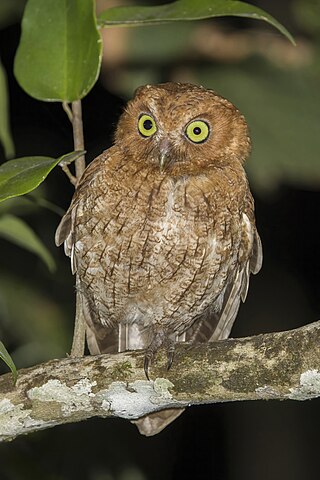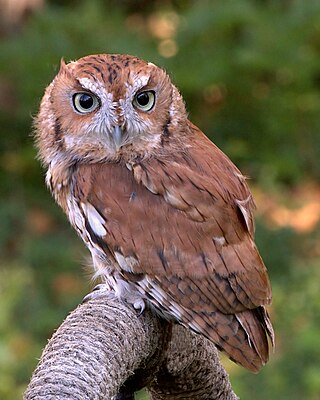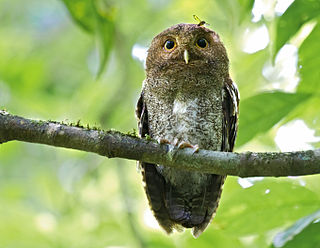
The blue-tailed emerald is a hummingbird in the "emeralds", tribe Trochilini of subfamily Trochilinae. It is found in tropical and subtropical South America east of the Andes from Colombia east to the Guianas and Trinidad, and south to northern Bolivia and central Brazil.

The western emerald is a species of hummingbird in the "emeralds", tribe Trochilini of subfamily Trochilinae. It is found in Colombia and Ecuador.

The straight-billed hermit is a species of bird in the family Trochilidae, the hummingbirds. It is found in Brazil, Colombia, Ecuador, French Guiana, Guyana, Peru, Suriname, and Venezuela.

Geoffroy's daggerbill, Geoffroy's wedgebill, or eastern wedge-billed hummingbird is a species of hummingbird in the family Trochilidae. It is found in Bolivia, Colombia, Ecuador, Peru, and Venezuela.

The rufous nightjar is a species of nightjar in the family Caprimulgidae. It is found in Argentina, Bolivia, Brazil, Colombia, Costa Rica, Ecuador, Guyana, Panama, Paraguay, Peru, Saint Lucia, Suriname, Trinidad and Tobago, and Venezuela.

The scarlet-fronted parakeet, known in aviculture as the scarlet-fronted conure,red-fronted conure, or Wagler's conure, is a Near Threatened species of bird in subfamily Arinae of the family Psittacidae, the African and New World parrots. It is found in Colombia and Venezuela.

The black-headed parrot is a species of bird in subfamily Arinae of the family Psittacidae, the African and New World parrots. Other colloquial names are black-crowned parrot, black-capped parrot, black-headed caique, and for subspecies P. m. pallidus, pallid caique. It is found in Brazil, Colombia, Ecuador, French Guiana, Guyana, Peru, Suriname, and Venezuela.

The rufous-banded owl is a species of owl in the family Strigidae. It is found in Bolivia, Colombia, Ecuador, Peru, and Venezuela.

The Central American pygmy owl is a species of owl in the family Strigidae. It is found in Belize, Colombia, Costa Rica, Ecuador, Guatemala, Honduras, Mexico, Nicaragua, and Panama.

The tropical screech owl is a small species of owl in the family Strigidae. It is found in Costa Rica, Panama, Trinidad, and every mainland South American country.

The Middle American screech owl, also known as the Guatemalan screech owl, is a species of owl in the family Strigidae. It is found from northern Mexico to western Panama.

The Yungas screech owl, also known as montane forest screech-owl and Hoy's screech owl, is a species of owl in the family Strigidae. It is found in Argentina and Bolivia.

The long-tufted screech owl is a species of "typical owl" in the subfamily Striginae. It is found in Argentina, Brazil, and Uruguay.

The ocellated woodcreeper is a species of bird in the subfamily Dendrocolaptinae of the ovenbird family Furnariidae. It is found in Bolivia, Brazil, Colombia, Ecuador, Peru, and Venezuela.

Screech owls are typical owls (Strigidae) belonging to the genus Megascops with 23 living species. For most of the 20th century, this genus was merged with the Old World scops owls in Otus, but nowadays it is again considered separately based on a range of behavioral, biogeographical, morphological, and DNA sequence data.

The gartered trogon, also known as the northern violaceous trogon, is a bird in the family Trogonidae, the quetzals and trogons. It is found in Mexico, all of Central America, and Colombia, Ecuador, Peru, and Venezuela.

Tschudi's woodcreeper is a passerine bird native to South America. It belongs to the genus Xiphorhynchus in the woodcreeper subfamily, Dendrocolaptinae. It is usually regarded as a subspecies of the ocellated woodcreeper. It is named after Johann Jakob von Tschudi, the Swiss explorer and naturalist who first described the bird.

The Amazonian trogon, is a species of bird in the family Trogonidae, the trogons and quetzals. It is found in Bolivia, Brazil, Colombia, Ecuador, Peru, and Venezuela.

The Chocó screech owl is a species of owl in the family Strigidae. It is found from central Panama to western Ecuador.

The vermiculated screech owl, is a subspecies, or possibly separate species, of owl in the family Strigidae. It is found in Costa Rica, Nicaragua, and Panama.






















